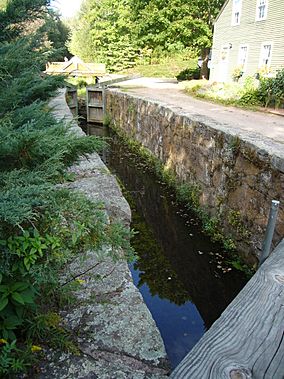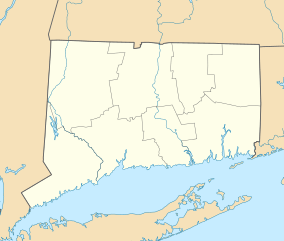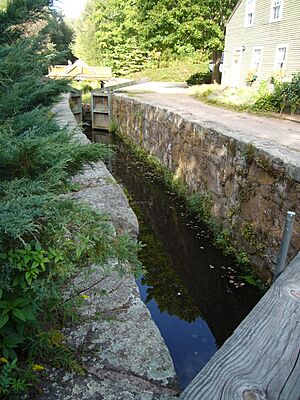Farmington Canal State Park Trail facts for kids
Quick facts for kids Farmington Canal State Park Trail |
|
|---|---|

Restored Lock 12
|
|
| Location | Cheshire, Hamden, New Haven, Connecticut, United States |
| Elevation | 135 ft (41 m) |
| Established | Unspecified |
| Governing body | Connecticut Department of Energy and Environmental Protection |
| Website | Farmington Canal State Park Trail |
The Farmington Canal State Park Trail is a special Connecticut state park. It's part of the longer Farmington Canal Heritage Trail. This park is located in the towns of Cheshire and Hamden.
The trail within the park is over 17.0 miles (27.4 km) long. It stretches from Lazy Lane in Southington to Todd Street in Hamden. Along the way, you can see the historic Lock 12. This restored lock is south of Brooksvale Road in Cheshire. The trail is paved and great for many activities. People enjoy hiking, biking, jogging, in-line skating, and even cross-country skiing here.
Contents
A Journey Through Time
The path where the trail now sits has a long history. Native Quinnipiac tribes used it as a trail many years ago. Later, colonists expanded it into a road.
Building the Canal
In 1822, people suggested digging a canal for water travel. This canal would help boats avoid busy river traffic. The project officially started on July 4, 1825. This marked Connecticut's entry into the "canal craze." It was a new era for transportation in the state.
The groundbreaking ceremony was simple. Connecticut Governor Oliver Wolcott Jr. turned the first shovel of earth. But the shovel broke, which some saw as a bad sign.
The canal began at Long Wharf in New Haven, Connecticut. It left the state near the Congamond Ponds, about 56 miles (90 km) north. The canal had 28 "lift locks." These locks were like water elevators for boats. They were 90 feet (27 m) long and 12 feet (3.7 m) wide. Locks were needed because the land changed a lot in height from New Haven to Massachusetts.
The first 1.25 miles (2.01 km) of the canal had strong stone walls. But most of the canal was a simple ditch. It was about 4 feet (1.2 m) deep. Only flat-bottomed boats could use it. Many people called the canal Connecticut's biggest engineering achievement before railroads.
Canal Operations and Challenges
The first parts of the canal opened in 1828. Mules pulled the canal boats along the waterway. The whole canal was finished in the late 1830s.
However, the canal's operation depended on the weather. During dry spells, sections of the canal would close. Despite these issues, the canal greatly helped local businesses and industries.
By 1836, the companies running the canal were in deep debt. A new company, the New Haven-Northampton Company, took over on June 22, 1836. The original investors lost a lot of money, about $1 million.
The Rise of Railroads
Soon, a new competitor appeared: the New Haven Railroad. This railroad ran between New Haven and Meriden, Connecticut. Stockholders asked the state for permission to build a railroad. They wanted to use the canal's path. A charter was granted, and railroad construction began in January 1847.
The railroad opened in sections. It reached Plainville in January 1848. Then Tariffville in January 1850, and Collinsville in February 1850. Building the railroad cost only $186,000.33 and took one year. The canal, however, cost over $1 million and took five years. The railroad saved money by using the canal's path. The canal's graded banks were perfect for a railroad bed.
From Rails to Trails
The railroad continued to operate until the 1980s. Then, most of the railroad lines along the canal were no longer used. This led to a "rails-to-trails" movement. People wanted to turn old railway lines into parks.
The Farmington Valley Trails Council started in 1992. Their goal was to save the canal path by making it a park. Money came from six towns and federal funding. Paving began, and the first section of the Farmington Canal Linear Park opened on May 22, 1994.
Lock 12: A Piece of History
On North Brooksvale Road in Cheshire, you'll find Lock 12. It's considered the "best-preserved relic" from Connecticut's canal era.
Lock 12 Historical Park has a pavilion and a picnic area. There's also a museum. In the early 1980s, the building at Lock 12 was given to the town of Cheshire. Raimon L. Beard helped a lot to save Lock 12.
The museum displays tools from the canal days. It also shows items made in Cheshire during that time. The museum is open on weekends from late spring to early fall. You can also visit by making an appointment.
Exploring the Trail
The Farmington Canal State Park Trail is split into two main parts.
One part is a 5.5 miles (8.9 km) multi-use trail. It goes south from Cornwall Street in Cheshire to Todd Street in Hamden. At the end of Todd Street, you'll find the start of Sleeping Giant State Park.
The second part is a 12.0 miles (19.3 km) trail. It runs from Connecticut Route 68 in Cheshire to Lazy Lane in Southington. This section was fully completed in the fall of 2017.
The trail is perfect for many activities. Walkers, joggers, bicyclists, and skaters all enjoy it. The Farmington Canal Heritage Trail is part of a bigger greenway. This greenway will connect sections in Avon, Farmington, and Simsbury. Eventually, it will form one very long trail.



